I wrote this article in 2010, after my first time racing at SCTA Speed Week at the Bonneville Salt Flats. Some of the prices for entry may not be completely correct as there can be changes over the years. The detailed info below relates to Bonneville in general, and to the SCTA events in particular. The AMA land speed events (Bonneville Motorcycle Speed Trials) operates a bit different, but all-in-all the information applies. Enjoy! - Tyler Malinky
There is everything on the Salt from mopeds to multi-million dollar streamliners. One of the great things about racing at Bonneville is there is such a mix from the low-budget, garage-built race machine to the high-dollar, corporate backed team with a semi-trailer and a crew in the double digits. The fact is with your entry fee and some time, skill and ingenuity you can be racing and having the time of your life without having to sell your blood to do it.
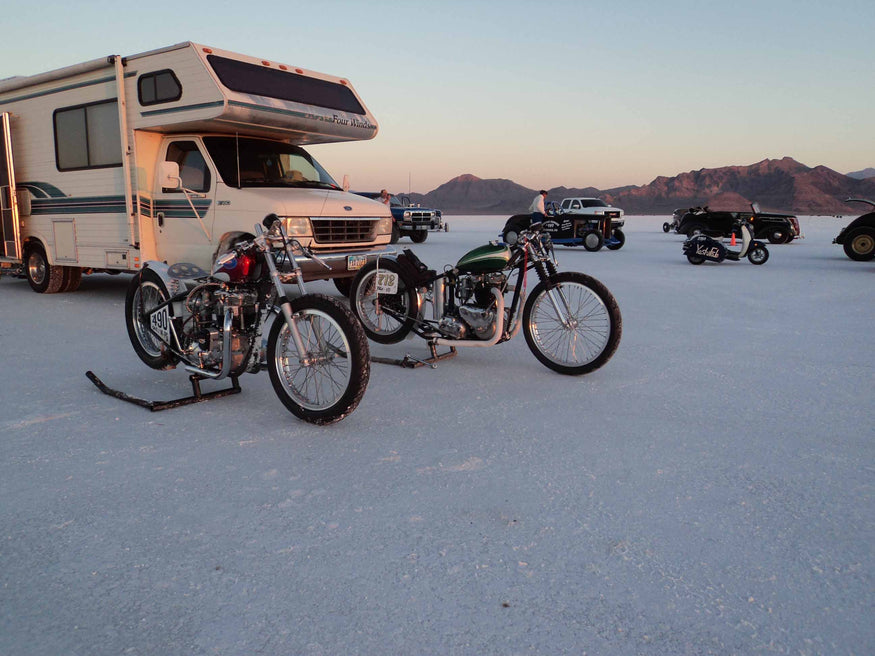
People who race at Bonneville commonly speak of ‘getting the bug’, or ‘the Salt getting in your veins’. Hanging out with my friend Wes White of Four Aces Cycle did just that, his passion and excitement for racing at Speed Week (2010 was his 5th year racing his Modified, Vintage Fuel 500cc Triumph) got me going and changed my 1955 Triumph street chopper build into a lean, green racing machine.
The transformation and all the race planning took place between February 2010 until about the night before we left in mid August. Not only did I get caught up in it, but my brother Kyle built a 1967 650 cc. Triumph race bike out of a motor and frame I had stashed in the shop. We were both Rookies at Bonneville, and with the help of Wes and his devoted crew members Dangerous Dave and Phil we learned the ropes, which I intend to do with you via this article.
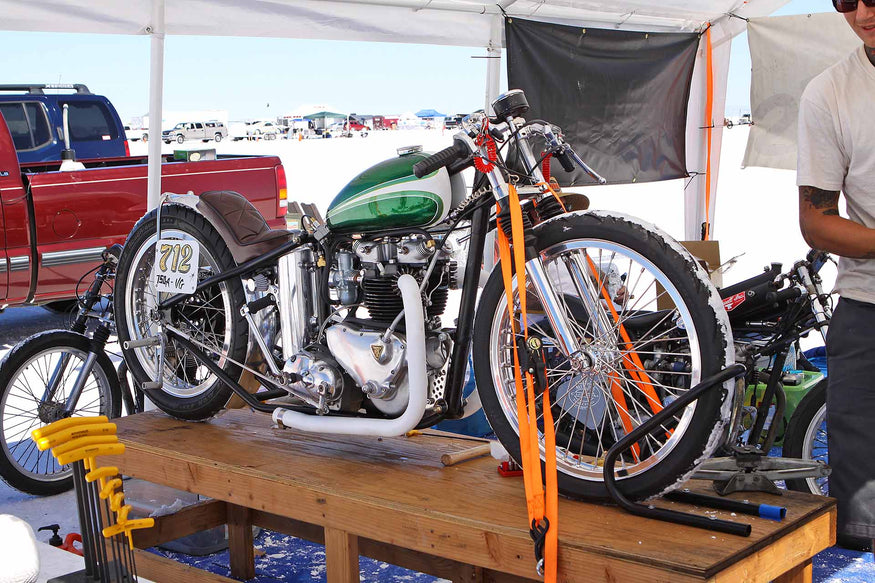
The Southern California Timing Association (SCTA) and Bonneville Nationals, Inc. (BNI) are the fine organizations responsible for putting on Bonneville Speed Week in August, as well as the World Finals in October. These SCTA-BNI meets include cars as well as motorcycles.
Also at the Salt Flats is a newer event, the BUB Motorcycle Speed Trials which takes place in late August each year and is an all-motorcycle event. The BUB meets are AMA records, which are different records than the SCTA events.
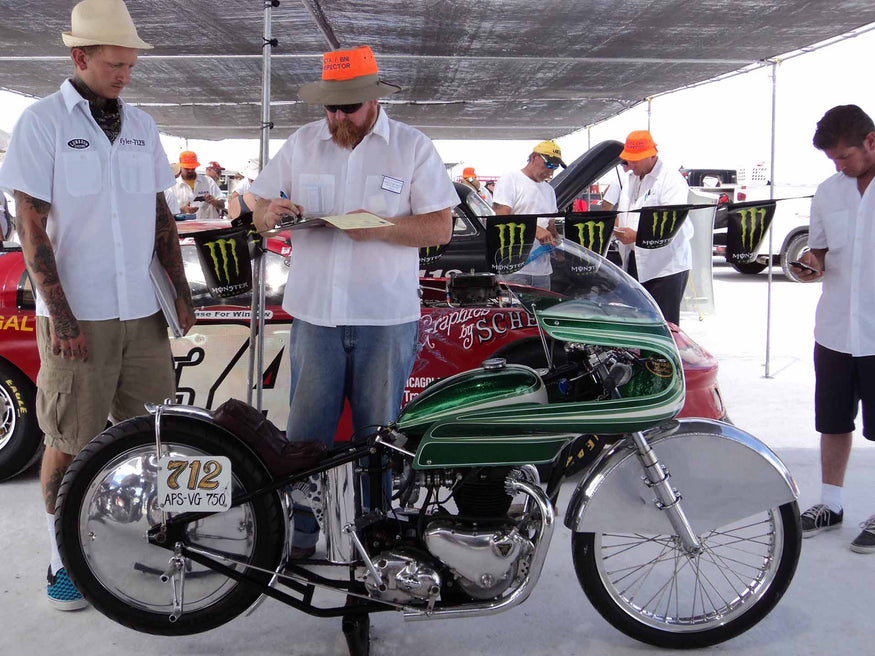
If you are planning on racing at an SCTA-BNI event, the first thing you need to do is order up the most current Rule Book with also contains all current records. Their website www.scta-bni.org also lists all updated records in red as they are broken, and an updated book will be available around March or April each year with the new records and any rule changes.
The Bonneville Motorcycle Speed Trials (formerly BUB Speed Trials) rules and records are available online at their website, www.bonnevillespeedtrials.com. These rules & records should be your bible and training manual. Read through it and study the rules and classes. Within an afternoon you should have the most important basics sorted, and you should refer back to it as you build your bike.
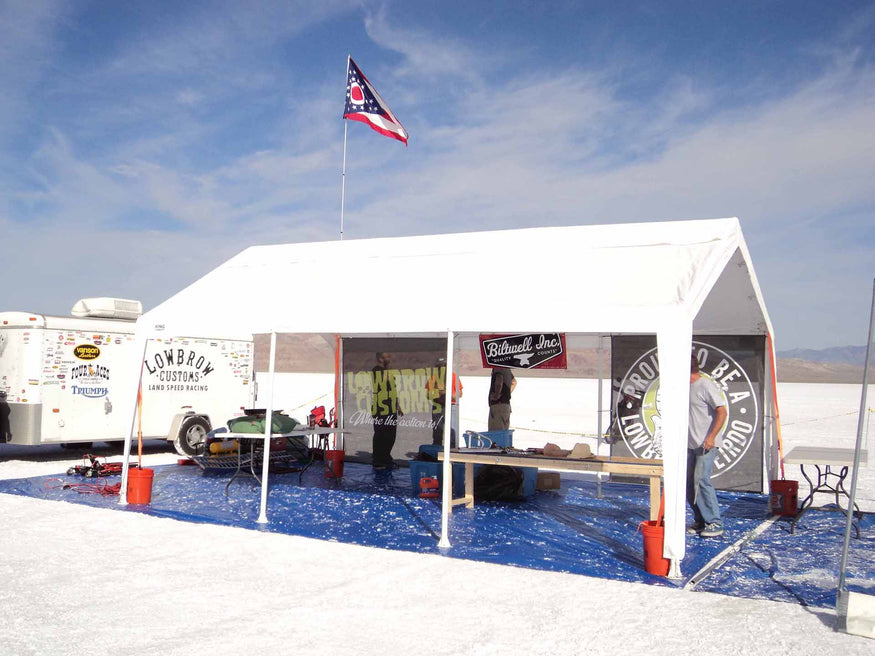
The Plan
There are many approaches to racing at Bonneville, many people use the "Hey, what class does my bike fit in"’ approach, though you will have more success with a bit of time spent learning what the classes are, what bikes fit into those classes, and looking for attainable records for a Rookie.
These records have been built on for a long time, and chances are if you just pick whatever one you fall into it will be a tall one. I suggest spending some time checking out the standing records and looking for a class that interests you, and one you think you may have a chance of setting a record in. The chase is what makes all the late nights and stress worth it.
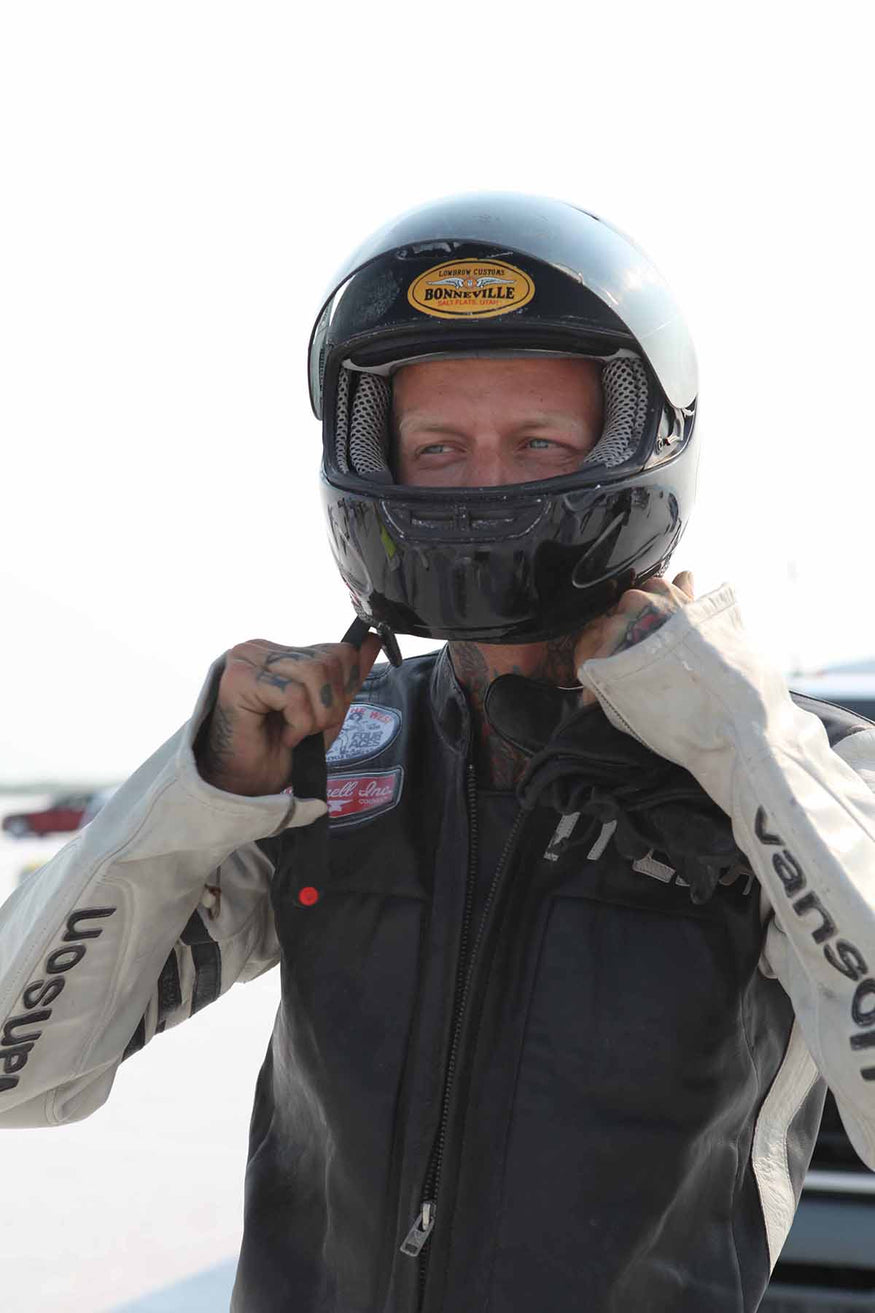
The Preparation
To race at an SCTA-BNI event, you have to be a Bonneville Nationals, Inc. Member. You just need to fill out the application and send in a check or credit card info, it is currently $70 a year You also need to send in your Speed Week entry form and a check for $400, which pays for your entry and the setup and support of Speed Week.
You also get a Speed Week poster, pin and patch. The last item needed is a medical form to fill out that includes an Authorization for Emergency Medical Care in case it is needed. All these forms can be found on the www.scta.bni.org website.
Be sure that you have a motorcycle endorsement on your driver license. At SCTA-BNI events there is no charge for adding an additional rider to an entered bike, the fee for changing classes is $250 (you have to go through Tech again to have your bike re-inspected when changing classes).

To race at a BUB event, you must be an AMA member, which costs $39 and can be completed online at www.ama-cycle.org. You have to have your AMA membership card present at the BUB meet. The BUB registration for AMA records is $425 if by the June 1st deadline, or $600 thereafter. There is also a ‘Run Wat-cha Brung’ class that is $200.
That basically allows you to run your bike on the Salt and get timed, but you are not competing in anything. At BUB events it is an additional $200 for an additional Rider on an entered bike and also for each Additional Class in addition to the one you entered under.
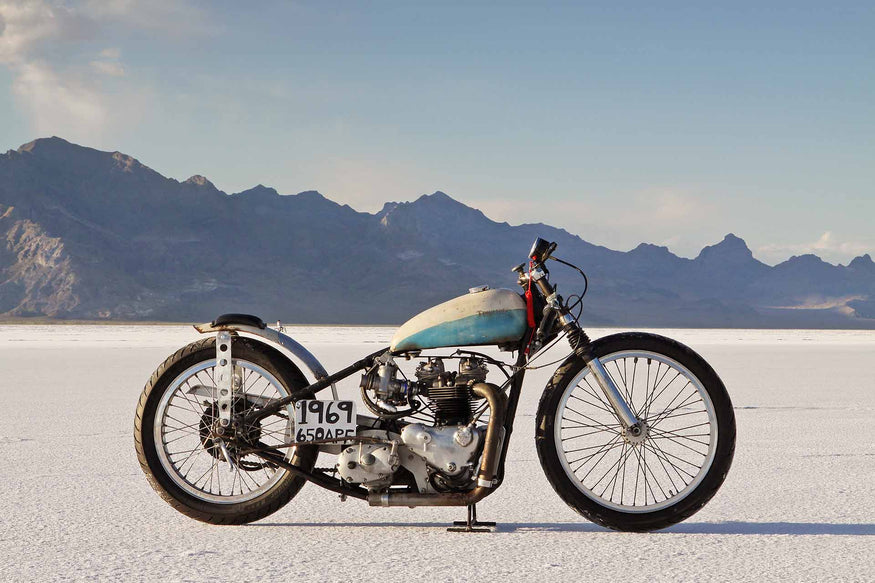
The Bike
The motorcycle you will race should depend heavily on your plan and the class you want to enter. No matter what make, model, or displacement bike you build for Bonneville, you are going to enjoy yourself. Chances are your street bike with some safety wire and tape over the headlight isn’t going to set the world on fire at Bonneville. If it will, you have a bitchin’ bike and go for it, but a purpose-built bike is the way to go if you are serious about racing. Stripped down, slippery as possible, with some safety features that don’t really mesh with street riding (such as a 30 degree turning radius on Special Construction bikes) and hopefully a hot motor that wants to absolutely scream for a few miles at a time.
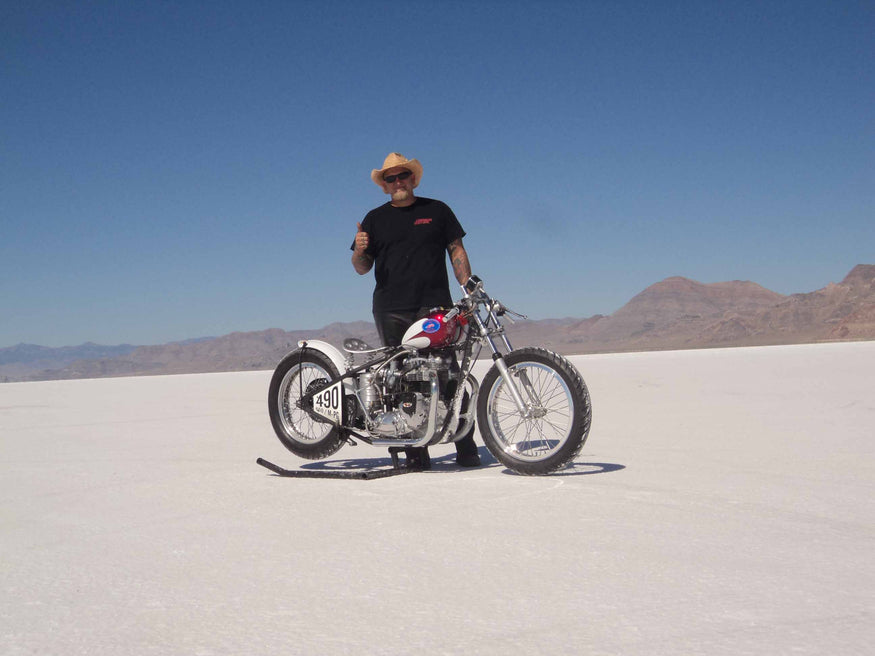
The Location
The Bonneville Salt Flats are located just outside of Wendover. Wendover is a city that sits right on the border of Utah and Nevada, while the Flats themselves are in Utah. That being said, if you are looking for the multitude of casinos and the strip club, you want to go to the Nevada side of town each night. Aside from casinos, the strip club, and some other amenities such as the local grocery store or an auto parts store, there isn’t too much in Wendover.
Getting a hotel room can be quite difficult, with people reserving rooms a year ahead, and casinos upping their rates about 400% during Speed Week. A popular alternative to the hub-bub of clanging slot machines, geriatrics cashing their social security checks in for casino chips, and greasers strutting around the parking lot at the Golden Nugget eyeballing eachother’s Model A’s is The Bend in the Road.
The Bend is just that, a 90 degree right turn as you pass the truck stop by the highway and head towards the entrance to the flats. You can’t miss it, rows of campers and RVs lined up, racers, crew and spectators all camping out each night then cruising back onto the Salt for the day’s racing. The Bend is free, just park and camp.
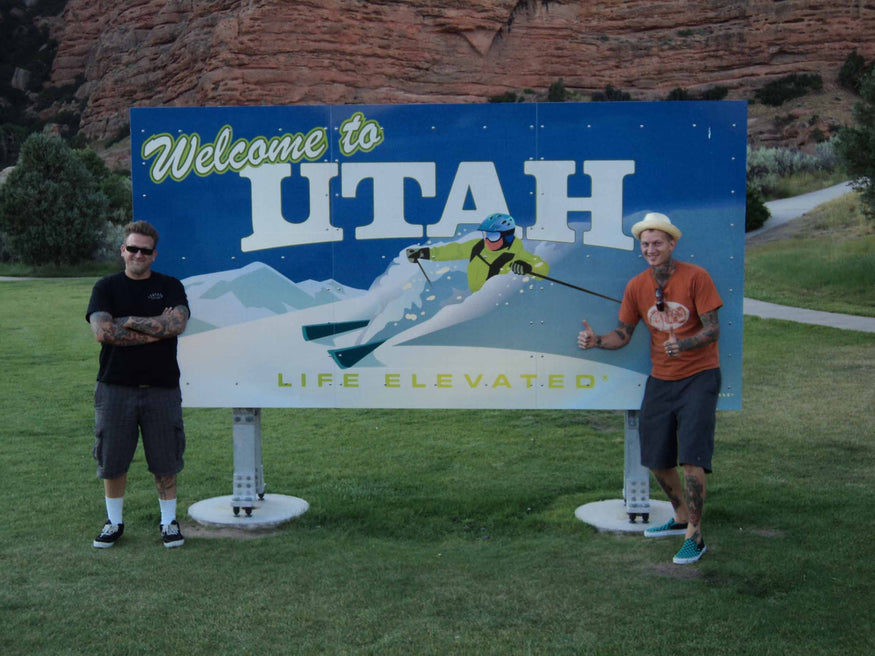
Safety Gear
Safety gear is extremely important at Bonneville, one of the main reasons being if you don’t have the proper gear, no matter how fast you think your bike will go, you will never find out as they won’t let you run. The days of the cowboys racing in bathing suits or jeans and a chopper motorcycle t-shirt are long gone. You will need a full suit of racing leathers without any perforations. One piece or two piece (350 degree zip-together).
If you are an average size person you may have luck with ‘off-the-shelf’ leathers or a used set via your favorite online auction site, but regardless leathers typically will be one of the larger investments for your trip to Utah if you don’t already have a suitable set.
There are several companies out there who custom make leathers. Vanson Leathers of Fall River, Massachusetts is one of them, and is also where myself, my brother, and Wes all got new leathers made this year. Bates Leathers is another long-standing leather company and is located in Signal Hill, California. You will also need sturdy leather boots (at least 8” tall) that you can still shift and ride comfortably in, leather gloves, and a Snell Rated M2005 helmet.

The Supplies
- Shade. Probably the most important, pop-up tents are OK but you really want to have as much shade as you can. As the sun rises and sets a 10’x10’ tent isn’t going to do you a whole lot of good, a larger canopy is ideal, or you can keep moving your trailer around to work in it’s shade if that is all you can come up with. Bring a good sun hat, sunglasses and sunscreen.
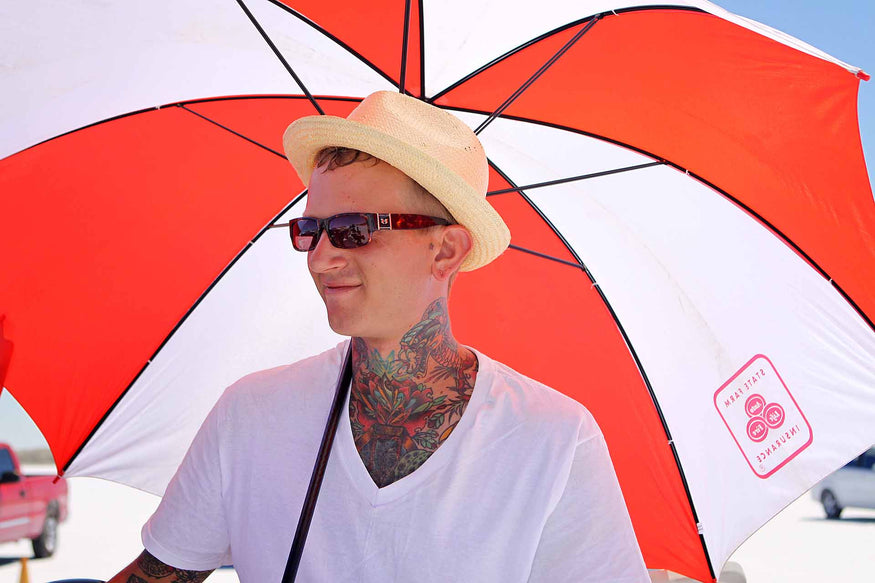
- Chase Vehicle & Trailer. You will need a vehicle (equipped with at least a 5 lb. Fire Extinguisher and a power-boosted CB, the hand held ones won’t cut it) and a trailer, hitch mounted carrier, or some way to transport your race bike to the line as well as back down the return road after your runs. There is no riding race vehicles except on the track, so don’t be one of the douchebags cruising through the pit on your race machine, you can get asked to leave and racing is over.
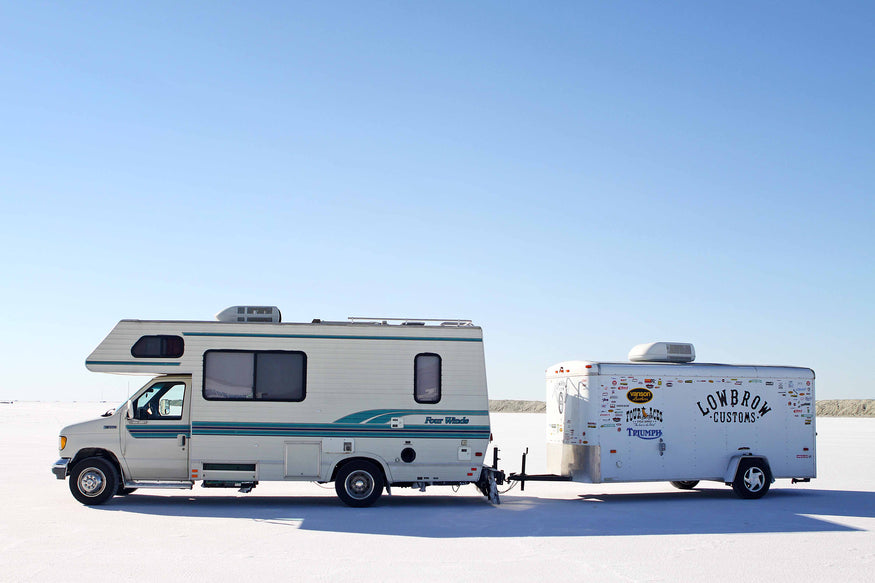
- Tarps. For the ground in the pit, and extras for covering your bike(s). The tarps can be held to the ground very effectively with drywall screws and some fender washers, the screws bite into the salt so well they will suck the washers in.
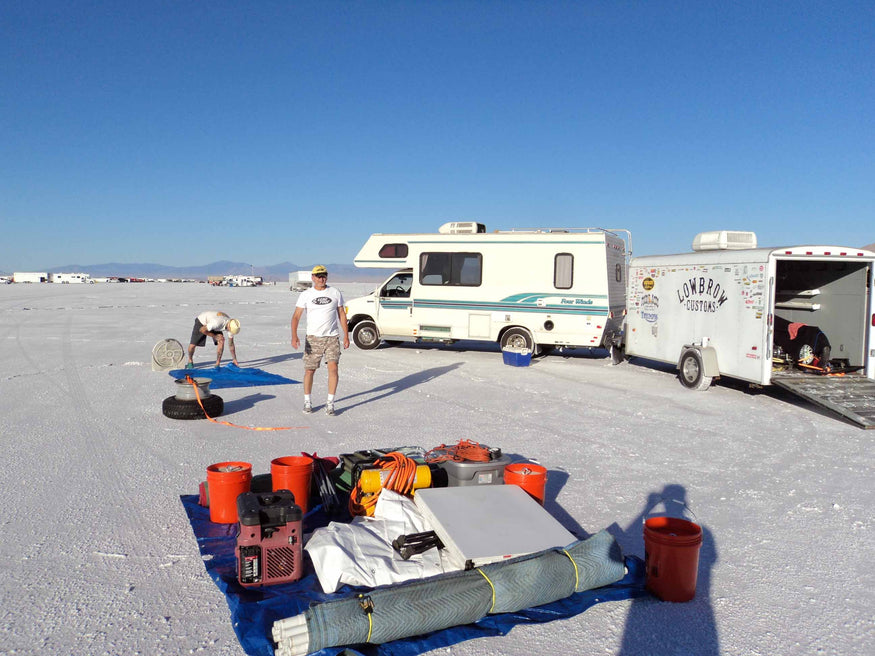
- Tools. Bring everything you need, especially specialty tools. If you need to borrow a 9/16” box wrench from someone, that isn’t an issue, but trying to find a clutch hub puller for your BSA could prove problematic. An air compressor and a generator aren’t necessity, but they sure are nice and make life easier. If you have a portable TIG that is great, but the general participant at Bonneville is very helpful, so if you need to weld up a broken aluminum chainguard you can likely find someone who will let you use their TIG for a few minutes (I did).
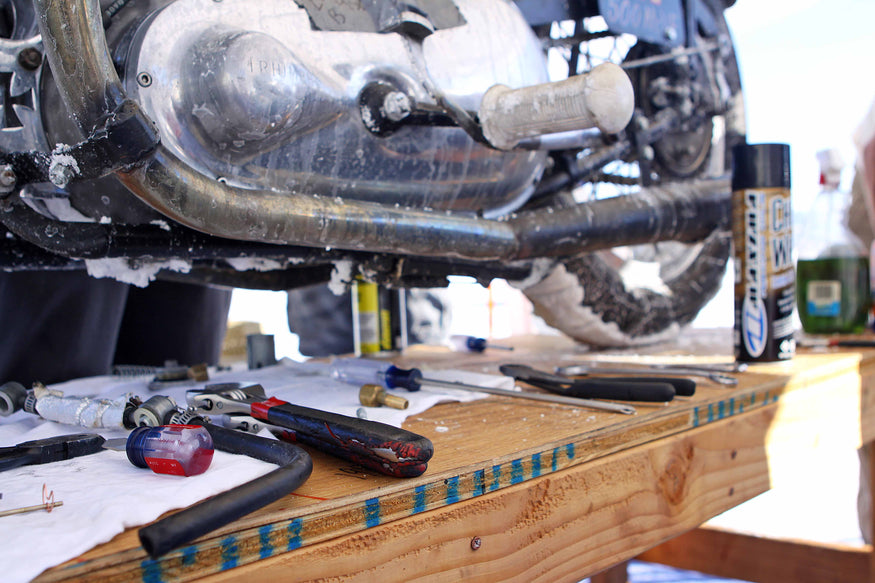
- Extra Parts. Plenty of hardware, nuts and bolts, duplicate cables, belts, chains, anything you might need. If your racing is done for the week because you didn’t have a primary belt, you will wish you would have spent the extra dough before you left. It depends how deep in you want to get, if you are comfortable with it bring parts to rebuild your top end.

- Metal. One thing I intended to bring, but forgot. Assorted scraps of steel and aluminum strap, tubing, and sheet. My brother and I both had to close in our open primaries to pass Tech, luckily one of our neighboring pits gave us a handful of aluminum strapping so we could quickly modify our bikes and pass tech.
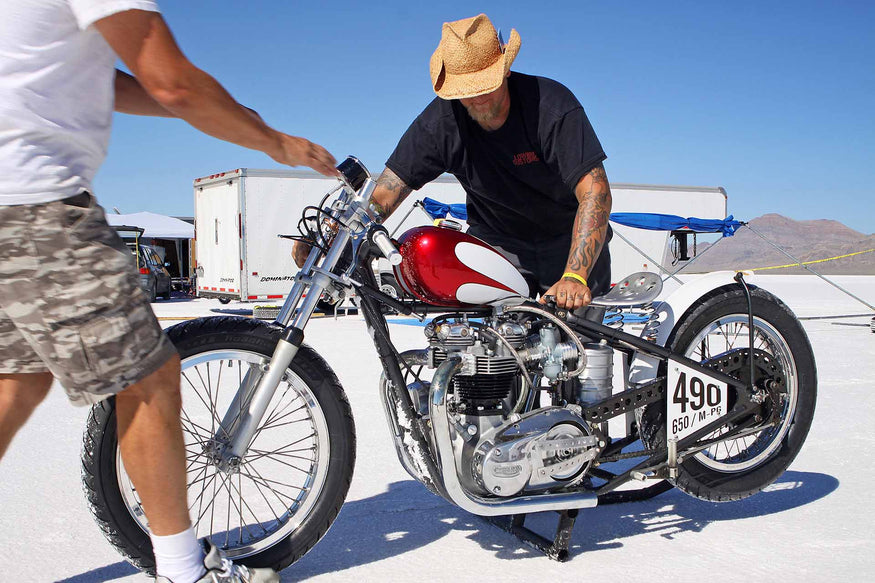
- Garden Sprayer. This is one we didn’t have, but were able to borrow Wes’. After a run your bike gets salt up under the tank, on cables, rocker boxes, all over. When you are checking or changing plugs, adjusting valves, or maybe even pulling your head you really don’t want salt falling in your motor. Spray your bike off really well and dry it before opening it up.
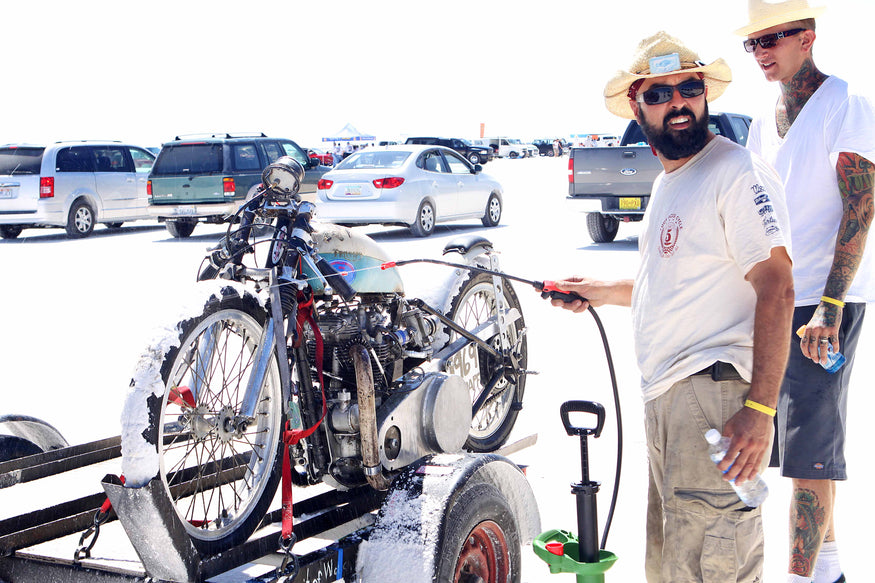
- Food & Water. Wendover or the truck stop aren’t really that far away, but when it is the middle of a race day, about the last thing you will want to do is take a break to leave the Salt for supplies. Bring food so you can scarf something down and keep wrenching and racing. Bring a lot of water, it is dry and hot.
- Garbage Bags. Trash bags, paper towels and rags are all extremely handy.
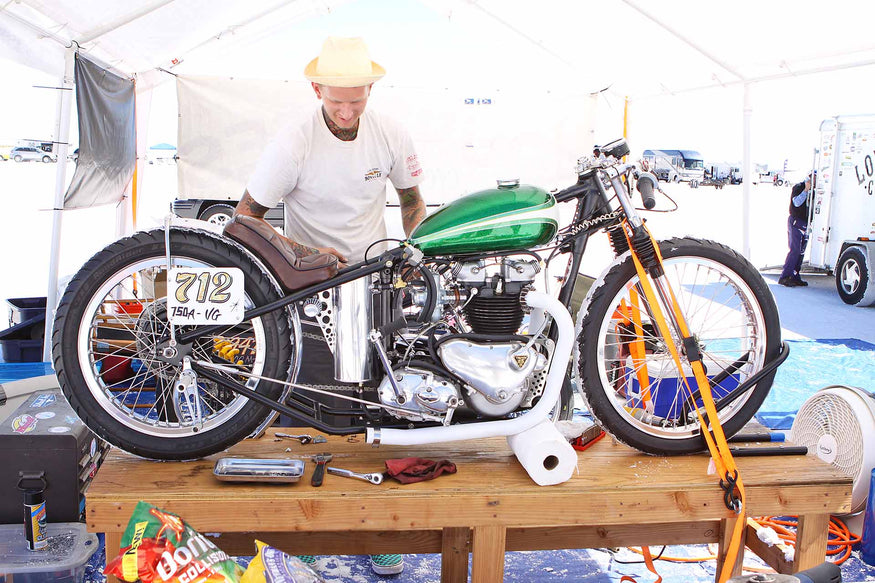
The Trip
Unless you are lucky enough to live in the area, chances are you are making a trek to go racing. We had a 1,900 mile journey, 35 hours straight through each way, and ended up with about 4,300 miles total round trip all told. We used a small RV and our enclosed race trailer and comfortable hauled two race bikes and tools without an issue. The RV also came in great handy as a chase vehicle with the ability to eat lunch and sit in air conditioning while waiting in line to race.
Many international teams were at Speed Week, including three separate French teams, the Australian Vincent Team, and individuals from Denmark, Germany, Sweden, and I am sure many others. People coming from international locations seemed to mostly ship their bikes via sea freight, fly into the US, and rent a U-Haul or RV and trailer to come to Bonneville. I thought the organization needed for our trip from Ohio was bad, but the international participants really had to jump some hurdles to be at Bonneville racing.
The Arrival
Cruising down the highway late at night, pitch black all around and you can’t tell if that is dusty desert and scrub on either side of the road, or Salt. We rolled into the Wendover area late at night, and it wasn’t until our RV blew a tire 6 miles outside of town that we stopped and realized that it was indeed Salt stretching to both sides of the road. Cool. We limped into town and got our tire changed at an all night tire service.
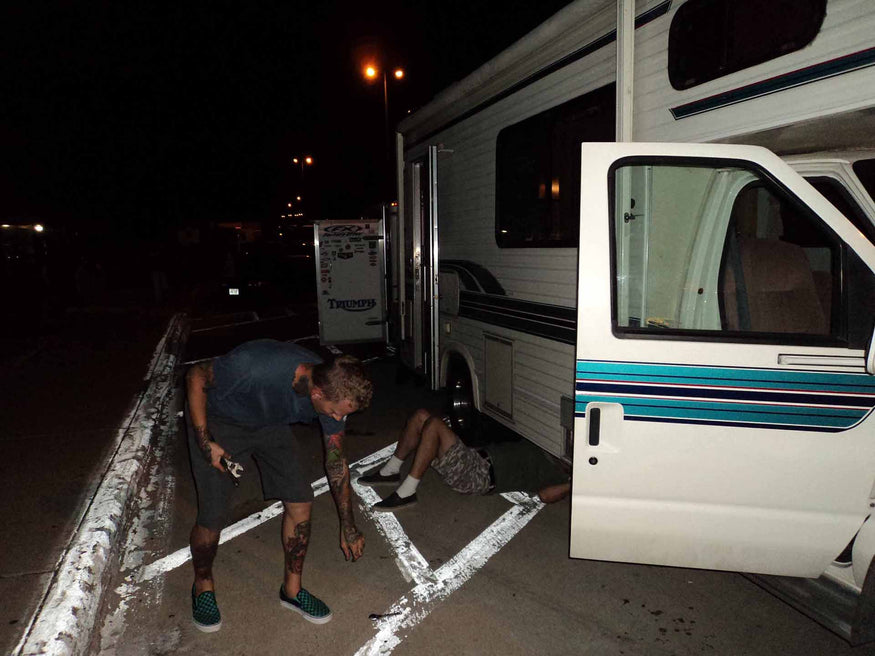
Once you make it to the Speed Week, one of the first things you can do is stake out your pit area. It is first come, first serve, just pick an open spot in the rows and set up your shade tent and drop your extra tools to mark your spot. You can then go to the registration booth and buy a Log Book if you hadn’t ordered one by mail. It has a serial number on the cover and also includes a sticker with the same number. That is your bike’s ID number. The sticker has to go on the frame of the bike on a fixed portion, it cannot go on a removable area such as a bolt-on hardtail. This sticker stays with your bike, make sure it is in an area where it cannot get damaged by fuel.
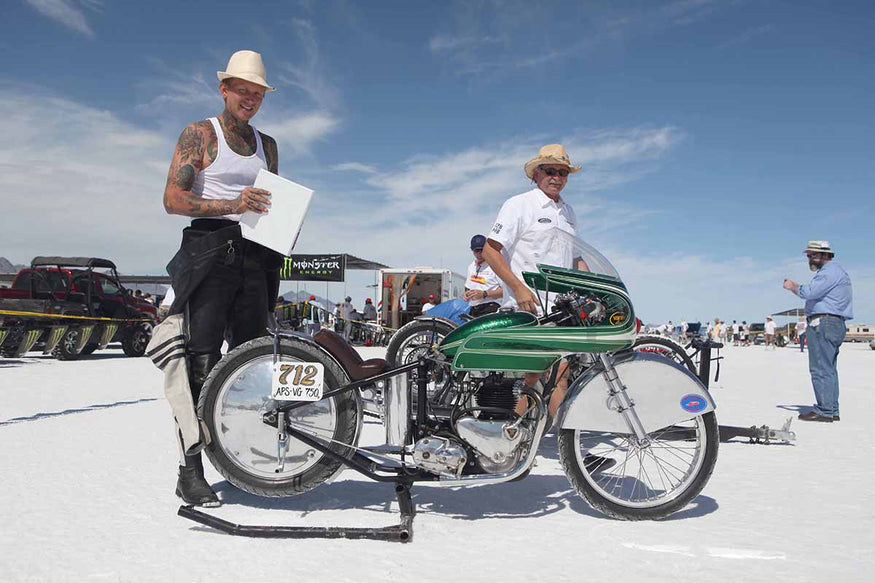
The next thing you may want to do is go get in line to get your bike tech’d so you can get ready to race. There is a Tech Inspection area with separate lines for car and motorcycle tech inspection. Get in line, and be sure to have your leathers, gloves, boots, and helmet in a bin, as they get inspected as well.
Your bike, if it hasn’t been raced at Bonneville or El Mirage before, will be considered a New Bike, and you a New Rider. One of the volunteer Tech Inspectors will go over your bike and go through a tech check list (also available online for your reference at the scta-bni.org website). They will make you aware of any issues or things you have to change before you are allowed to race.
Hopefully, you did your homework and built your bike to spec, or if there is an issue it is a small one and can be fixed or modified on the spot. Once you pass through tech successfully you can get your Inspected sticker that you put visibly on your bike fairing or tank so the starter at the line can see clearly that your bike is ready to run.
You also get your Driver wristband at this point, and your crew gets their crew wristbands which are a different color, as well as a couple of Bonneville Participant ballcaps and t-shirts.
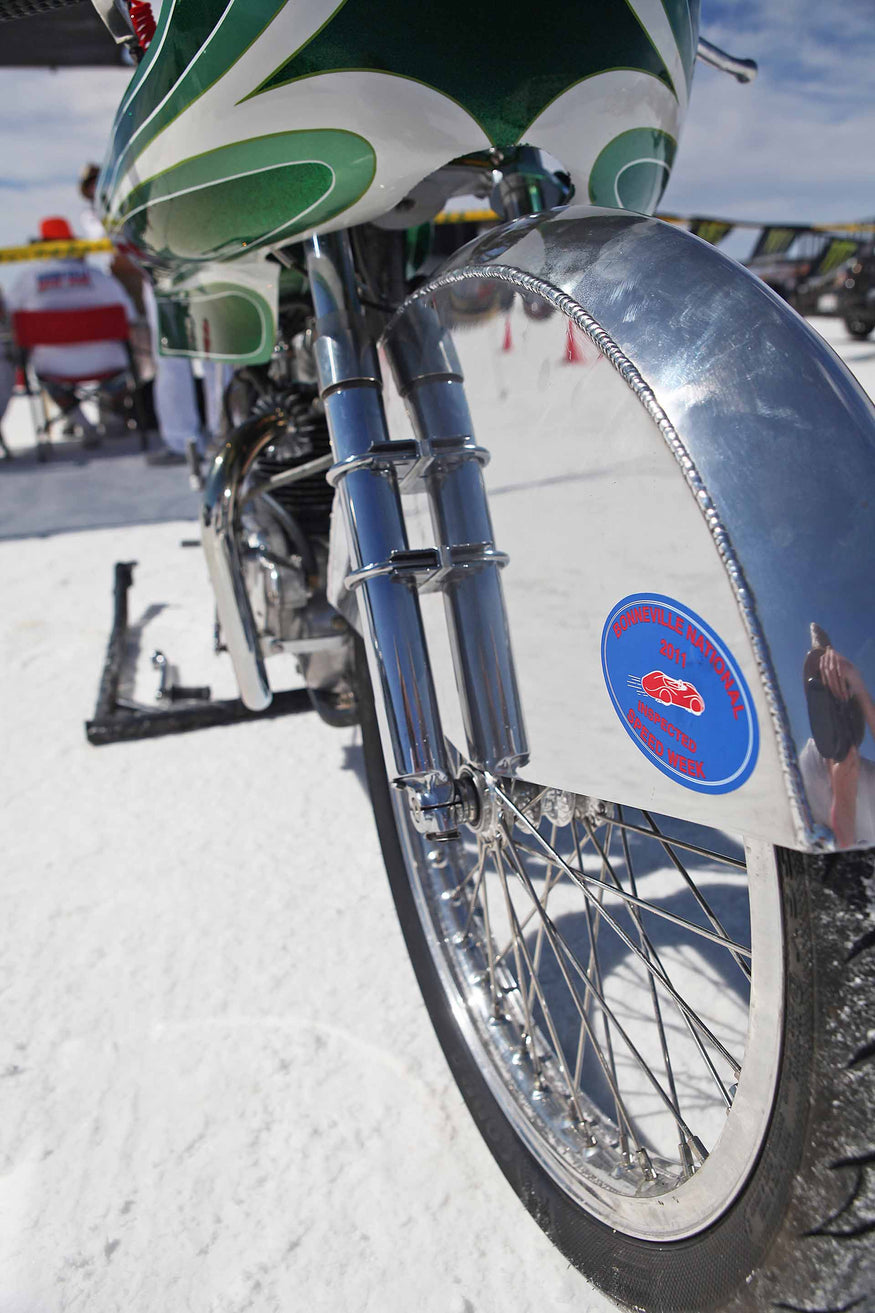
If you are a Rookie, you need to attend the Rookie Driver’s meeting. There is a Driver’s meeting the first day for all driver’s and crew, which opens Speed Week. Directly following that is the Rookie meeting, which all Rookie Driver’s and Crew need to attend.
During the meeting you learn about the courses, what to do in case of an emergency, and general etiquette. At the end of the meeting you get a circle sticker with an ‘R’ on it, this shows that you are a rookie and you still have to complete your Rookie Run. If you aren’t in town yet for the first meeting, they do daily Rookie Driver Meetings for those people who show up throughout the week.

Your first run down the Salt is your Rookie Run. Make sure the Starter at the line is aware you are a Rookie. He will give you his spiel and tell you what to do and what not to do. The throttle works both ways. Try and slow your breathing down, scream inside your helmet, do whatever you need to do because at this point you are excited and can’t believe you are finally about to run on the Salt.
They are basically looking to see that you are in control of your vehicle and can follow the rules. Rookie Runs have to be below 150 m.p.h., and you have to have a clean run through the timing lights and pulling off to the return road. You can have a Tech Inspector or the Starter sign off on your timing slip and remove the ‘R’ sticker on your helmet, congratulations, you are no longer a Rookie.
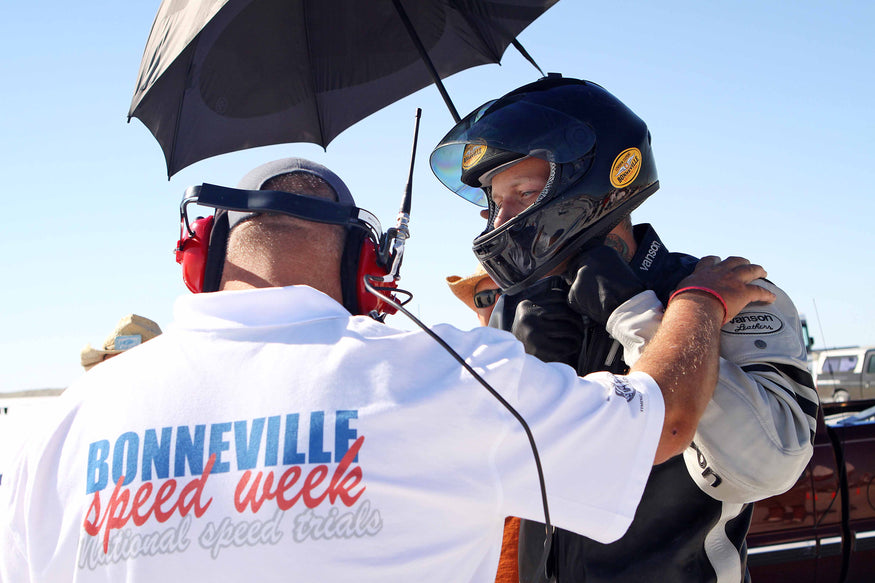
The Racing
Speed Week is typically set up with three courses. The Long Course, a 5 mile course (with three timed miles) for vehicles over 175 m.p.h., a Combo Course that can be used as a Long or Short course, and the Short Course, a 3 mile course (with two timed miles) for under 175 m.p.h. vehicles. Your Rookie Run would have been completed on the Short Course, and you can then choose to run on the Combo or Short Course, or if your bike is running over 175 m.p.h. you can move over to the Long Course.
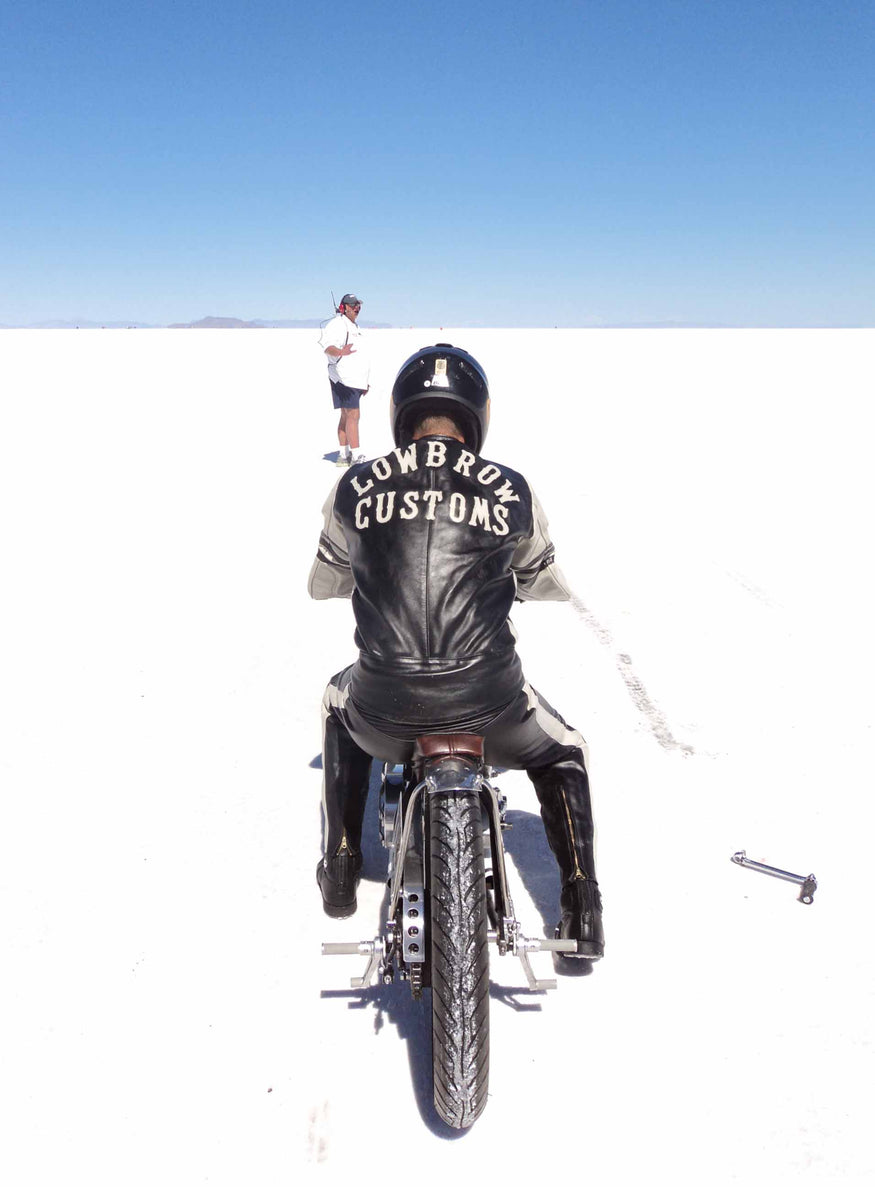
There are Return Roads that run to the left or right of the course, depending on what course you are on. The return road is always to the opposite side of that course’s timing tower. If you pull off the course towards the timing tower that is a sign of either a medical emergency, or that you lost parts on the course and the course has to be cleared. Either way they roll out fire and EMS to make sure you are okay.
In a clean run, or a run with mechanical trouble but no lost parts or injury, you pull off the course away from the timing tower and over to the return road. The return road runs parallel to the course and is about a quarter mile away. It is marked with orange cones and large black and white checkerboard flags about 10’ tall, you can’t miss it. Your chase vehicle follows you onto the course for just a moment after you take off then cuts over to the return road, driving up it until they find you and your vehicle, load it up, and bang a U-turn, heading down to the end to get your timing slip which will give you your speed through each timing light, date and time, temperature, wind speed and direction, and DA (Density Altitude).
The Bonneville Salt Flats is approximately 4,200 feet above sea level, but based on the given weather conditions at the time of your run it can vary easily by several thousand feet. That is why a morning run vs. an afternoon run can mean a jet change in your carburetors, and is also what makes running at Bonneville much different from cruising down your local fairway.
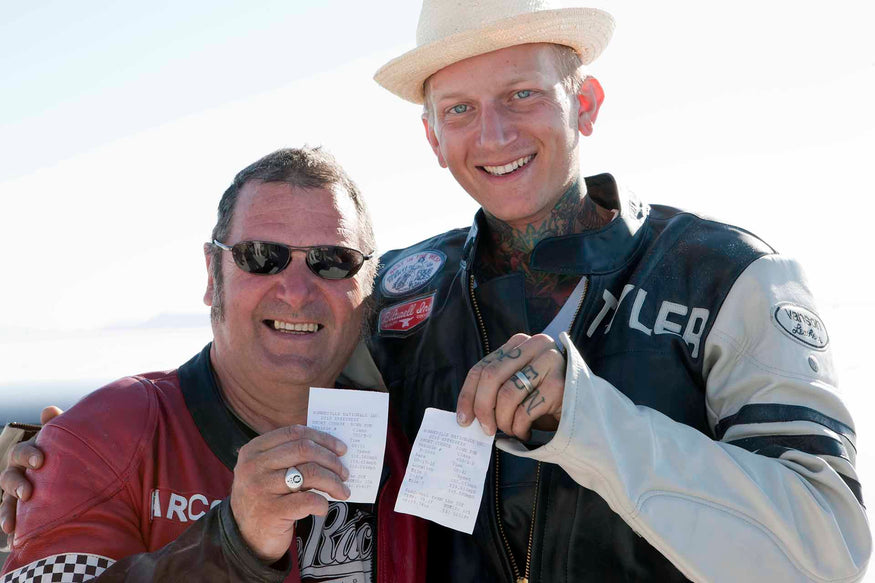
As soon as you are ready you get in line at one of the courses. There are two lines side-by-side at each course, and at the line riders alternate left and right. By the time you are about five vehicles back (in line in front of you, not counting the other side), your bike needs to be off the trailer. By third in line you need to be fully suited up in your leathers. Once the person in front of you goes, you bring your vehicle all the way up to the line. When the vehicle to your side goes, you will be next, so do whatever preparation necessary, start it up, make sure your helmet is on and visor down, petcocks on. Keep an eye on the Starter, he will clearly let you know when it is time to go, once the previous Driver has run the course and totally cleared it
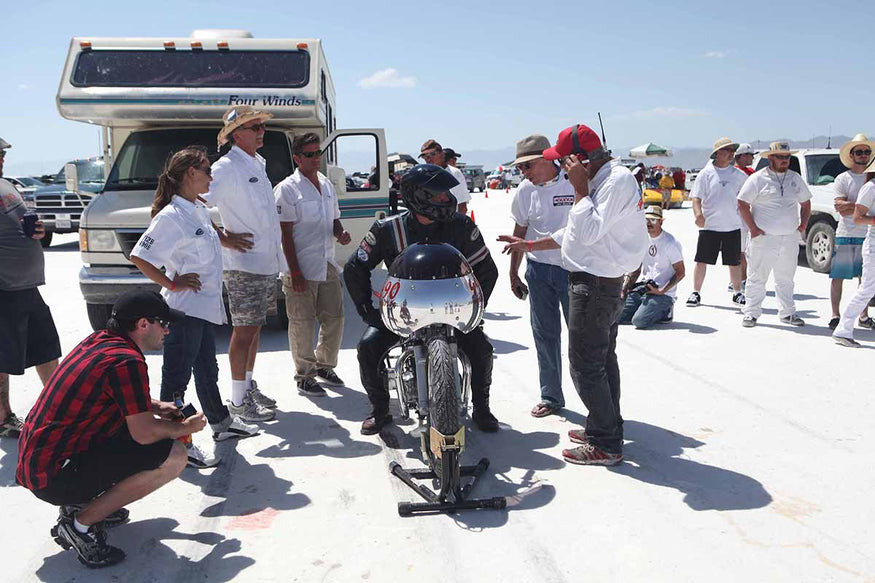
To qualify for a record you need to beat the existing record by at least .001 m.p.h. Not only do you have to beat the existing record once, you have to do a back-up run as well which is averaged to get your final speed. Once you get your timing slip and have a record-setting speed under your belt, you head over to Impound, located next to the Tech Inspection area, and give one of the Tech’s your timing slip and let them know you qualified for a record. Your bike is now ‘In Impound’ and you get 4 hours, or until about 8 p.m. when you have to leave the Salt Flats, whichever is longer, to work on your bike.
You are not allowed to do gearing changes or any other main performance modifications, but you can do maintenance and tuning such as valves, jetting, chain lubing and adjustment. You arrive at Impound the following morning by 6am and all the impound vehicles get in line at the course they qualified on for their back-up run.
Record runs are set based on a two-run average on the same course, over the same timed mile. That means if your qualifying record speed was at the 2 mile timing light on the Short Course, your back up run will be based on the 2 mile timing light on the Short Course as well. If you spin out, lose power, or otherwise can’t complete your back-up run (As I did on my back-up run at Speed Week 2010 by bending a valve on my ’55 Triumph) you lose your record attempt and have to start over with your first run. That is a good way to ruin a perfectly great morning.
Once you complete your second run and the average of the two runs beats the existing record (or if it is an Open record) you have to head back to Impound one more time for final tests. If you are running in the Gasoline class they test your gas to make sure it is what it is supposed to be (no nitro or additives!), if Fuel class it doesn’t matter you can run whatever you want. They check to make sure your bike meets the rest of it’s requirements, the main one being testing the displacement.
One way of doing it is filling the cylinder with hydraulic fluid. You have to disable your valves, on a Triumph this means removing your rocker boxes so the valves are closed, then the cylinder is filled with hydraulic oil via the spark plug hole.
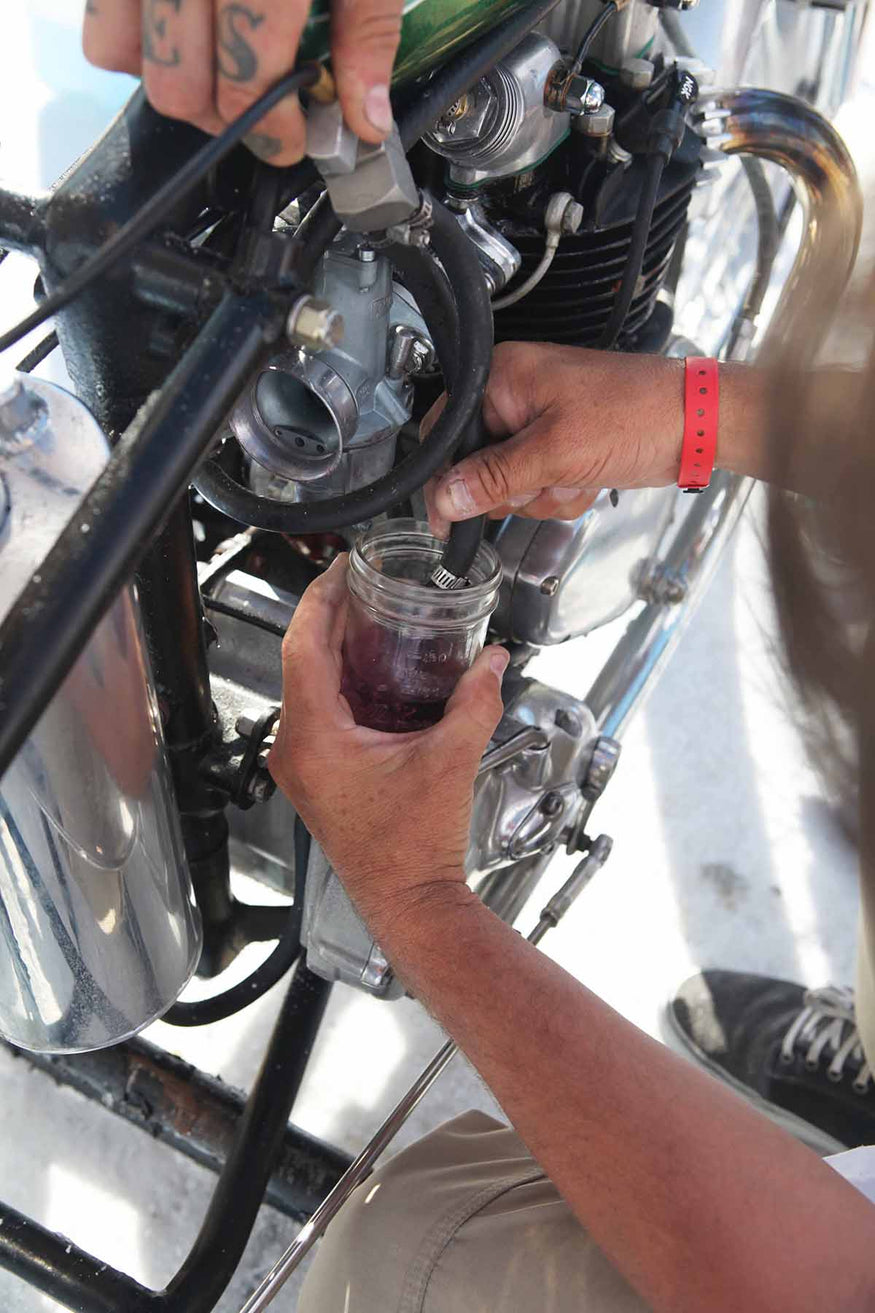
So you have set a National Speed Record, how does it feel? How are you going to get that giant trophy home and spend the cash prize? Oh wait, the trophy is small, and there is no cash prize. Or even a pretty girl in a bikini to put a lei around your neck. Your prize is the satisfaction that you went faster than the other guy. And you also get a brass timing tag sent to you in the mail that records your best run, and if you set a record you get a brass timing tag that records the record speed.

Now the question you have to ask yourself is, ‘What are you going to do to make it go faster?’ Answer this one correctly and each run you could be inching closer to that elusive record. August ends, and before you know it you are in planning mode for the next race, the next year. After bending the valve on my Triumph the second last day, I started making plans to return in October 2010 for World Finals. I had some unfinished business to take care of. Before we even left the Salt, plans were in motion and it was all set in my head. It wasn’t a surprise, just ask any of the racers who return year after year why they do it. The Salt gets in your blood.
Words by: Tyler Malinky
Photos by: Jon Glover, Kyle & Denny Malinky and Denis Boussard
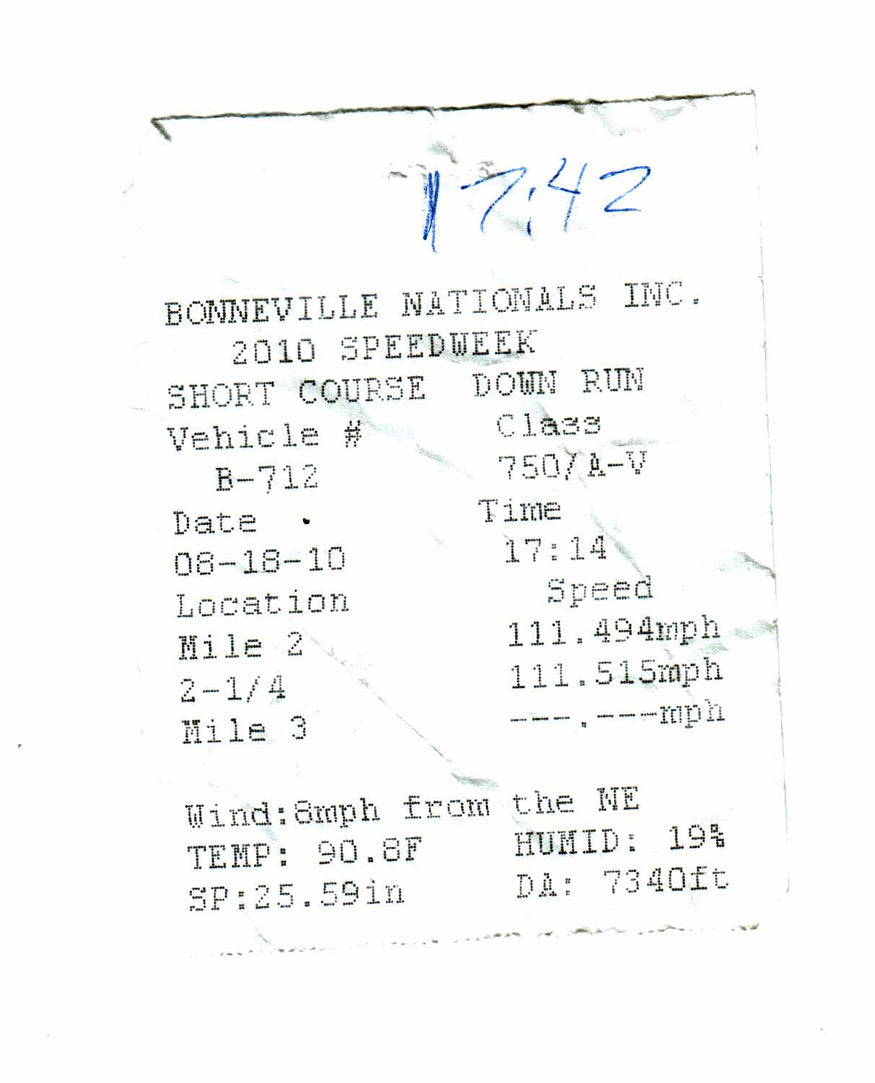
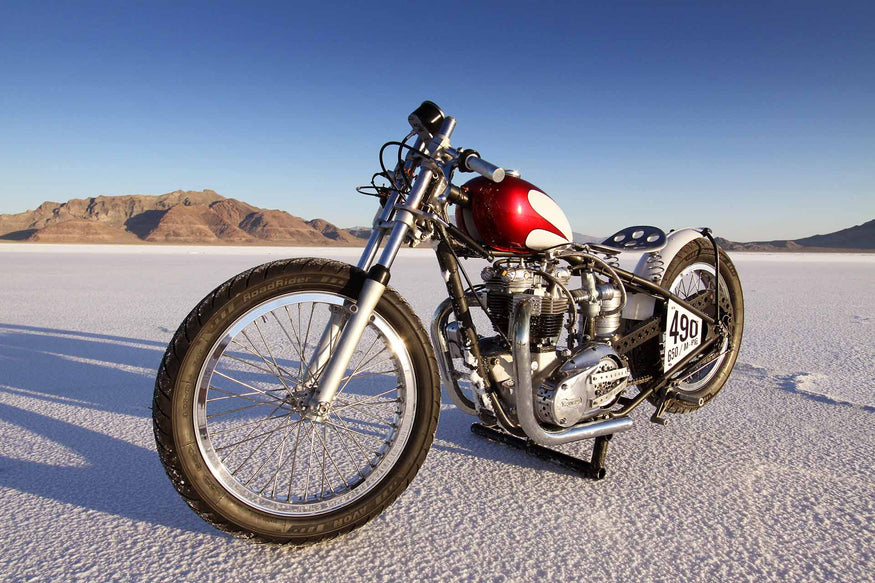
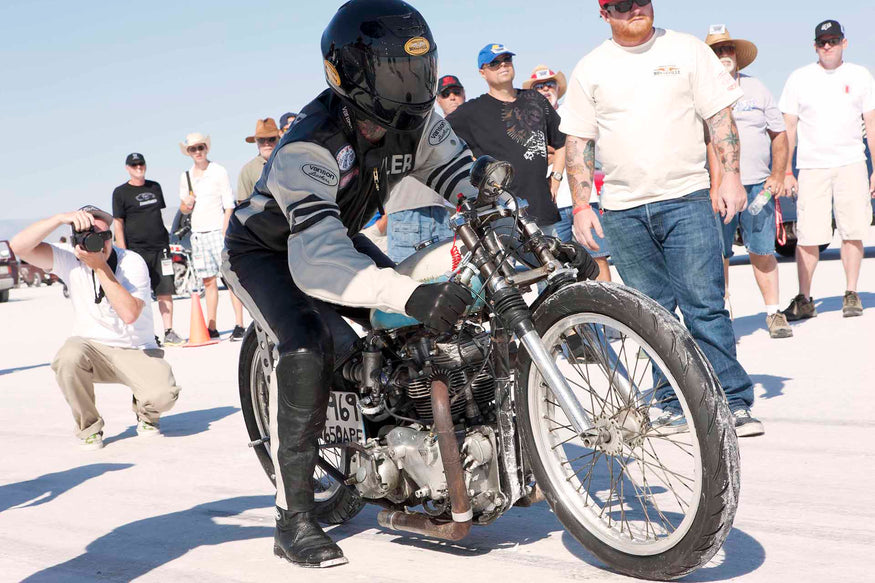
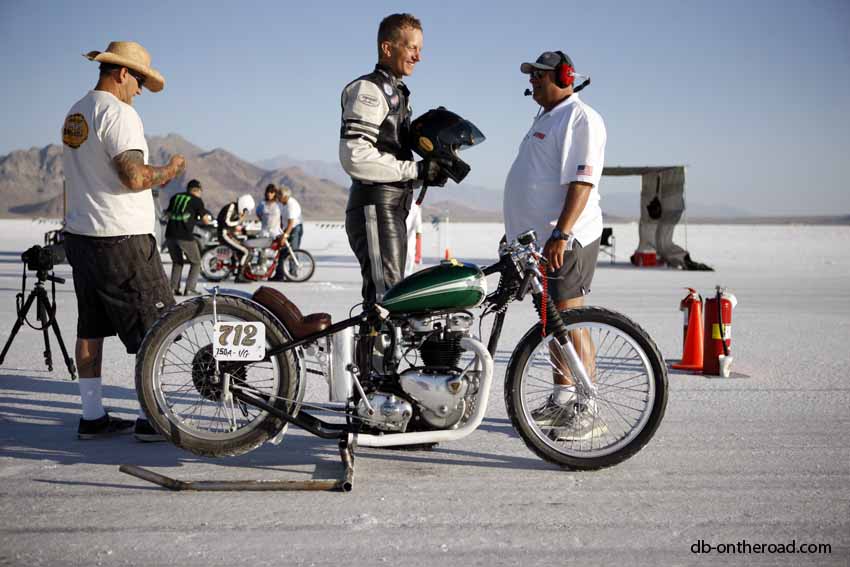
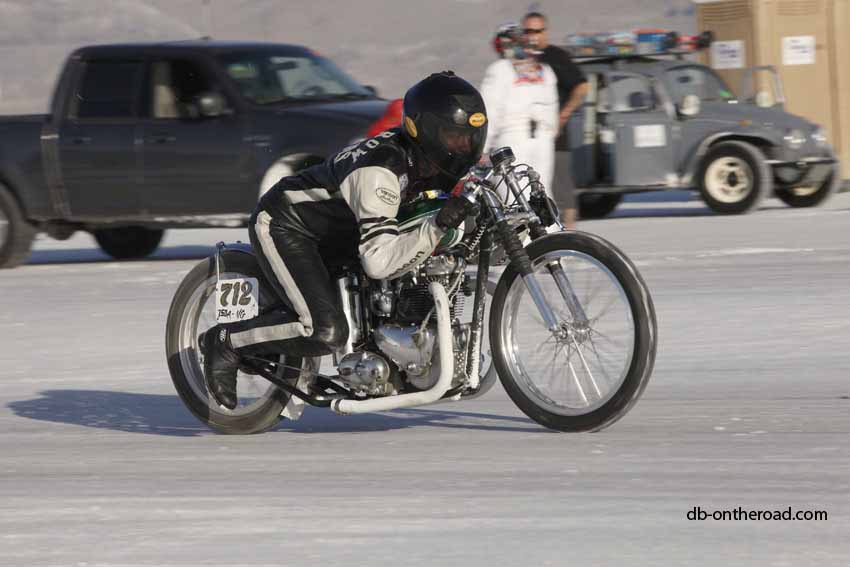
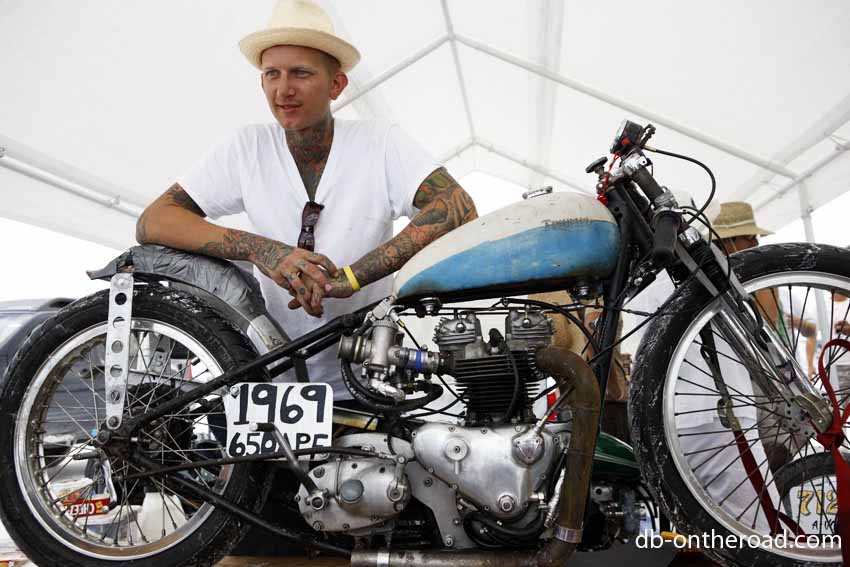
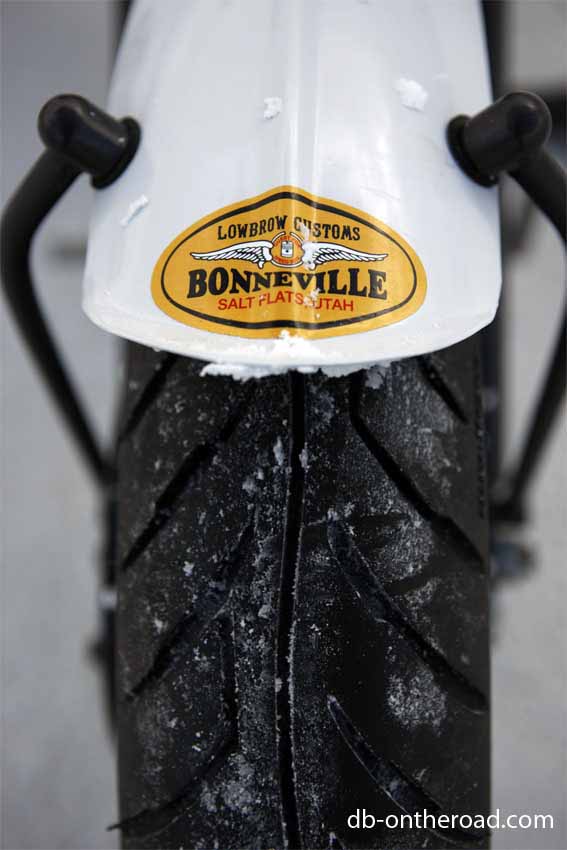
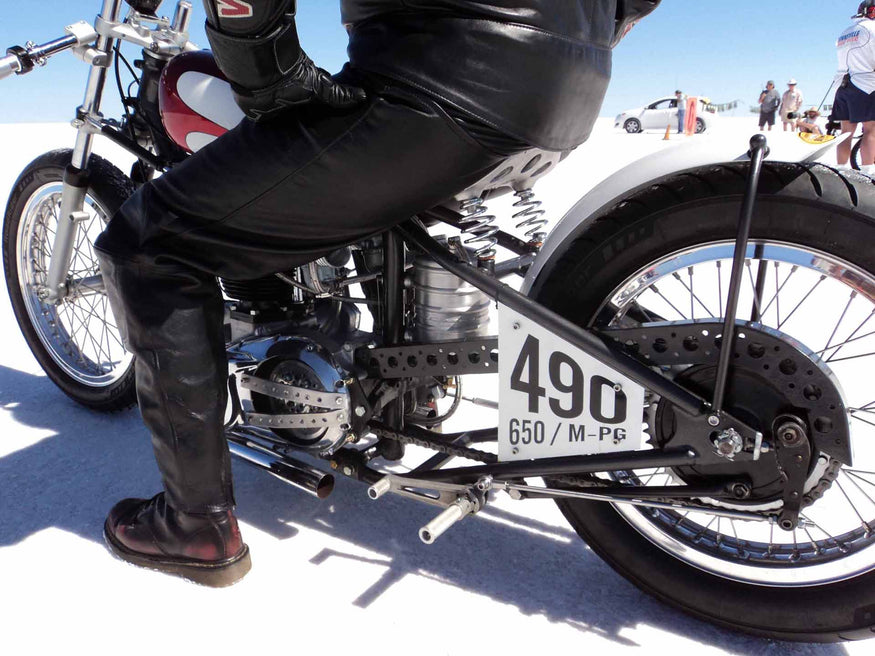
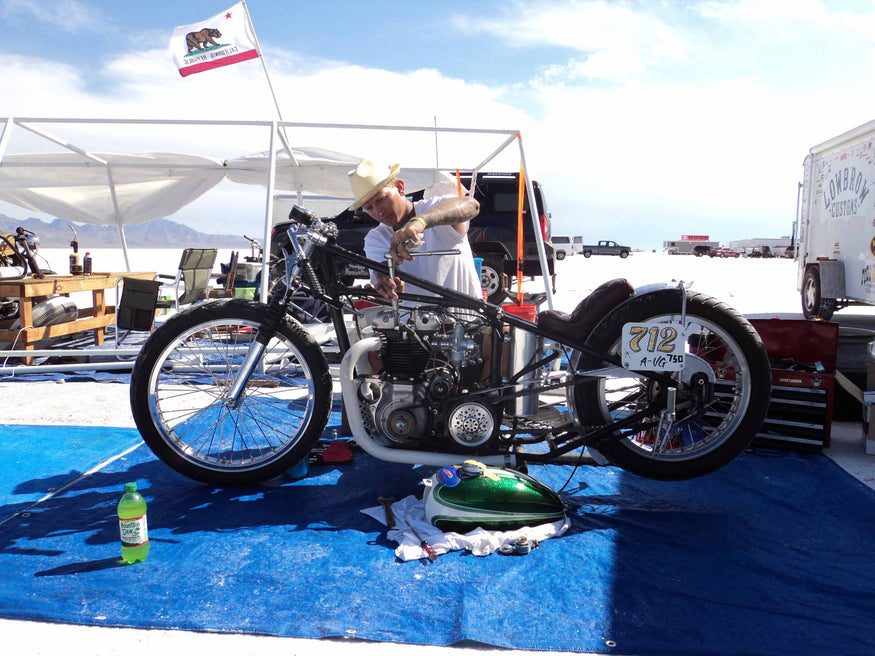

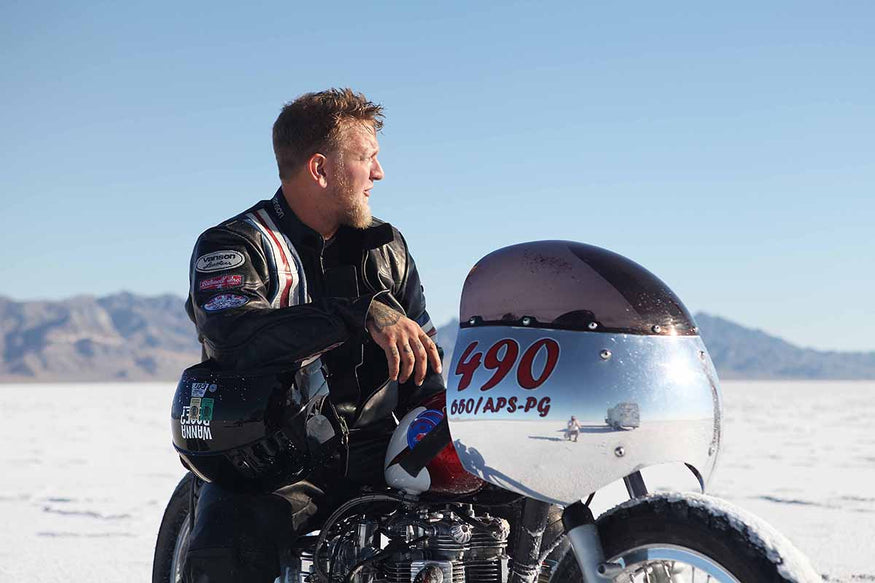


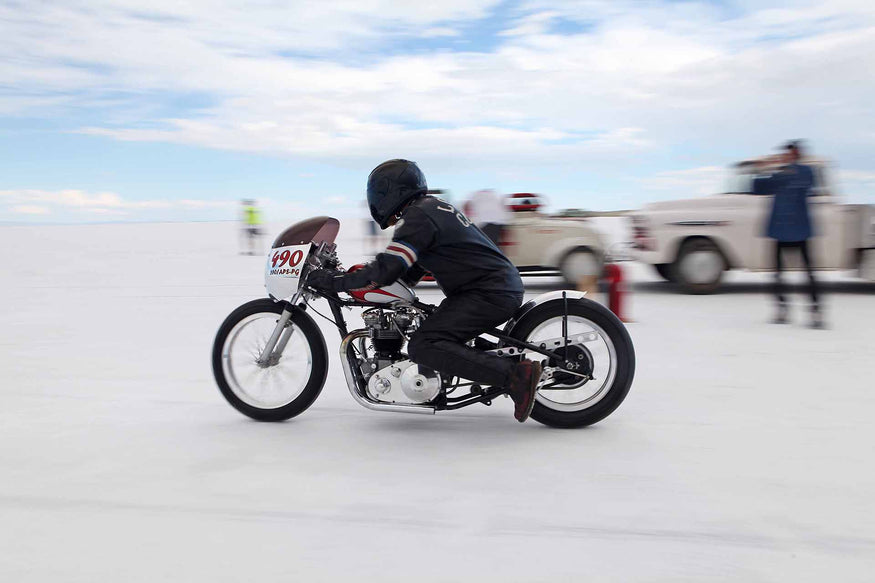
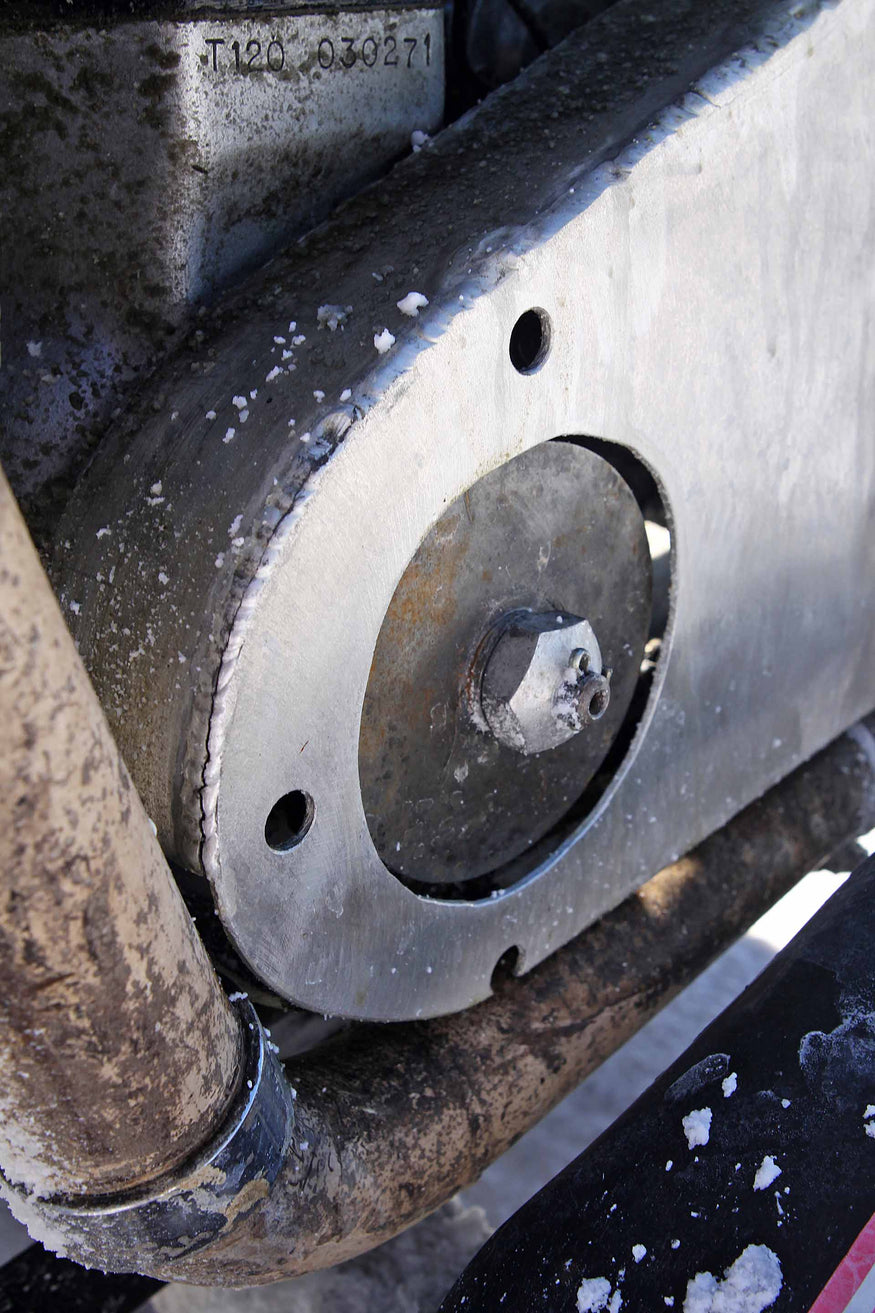
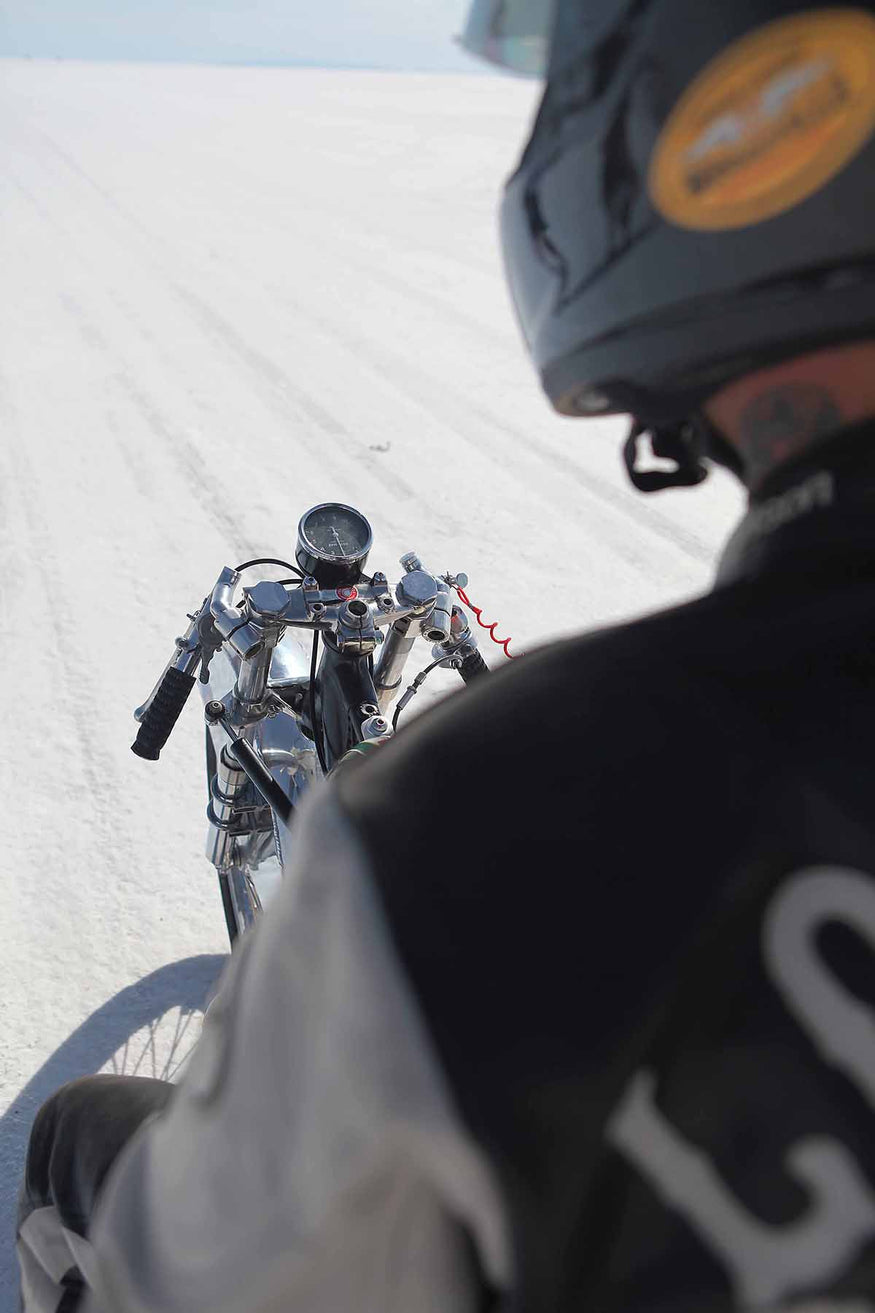
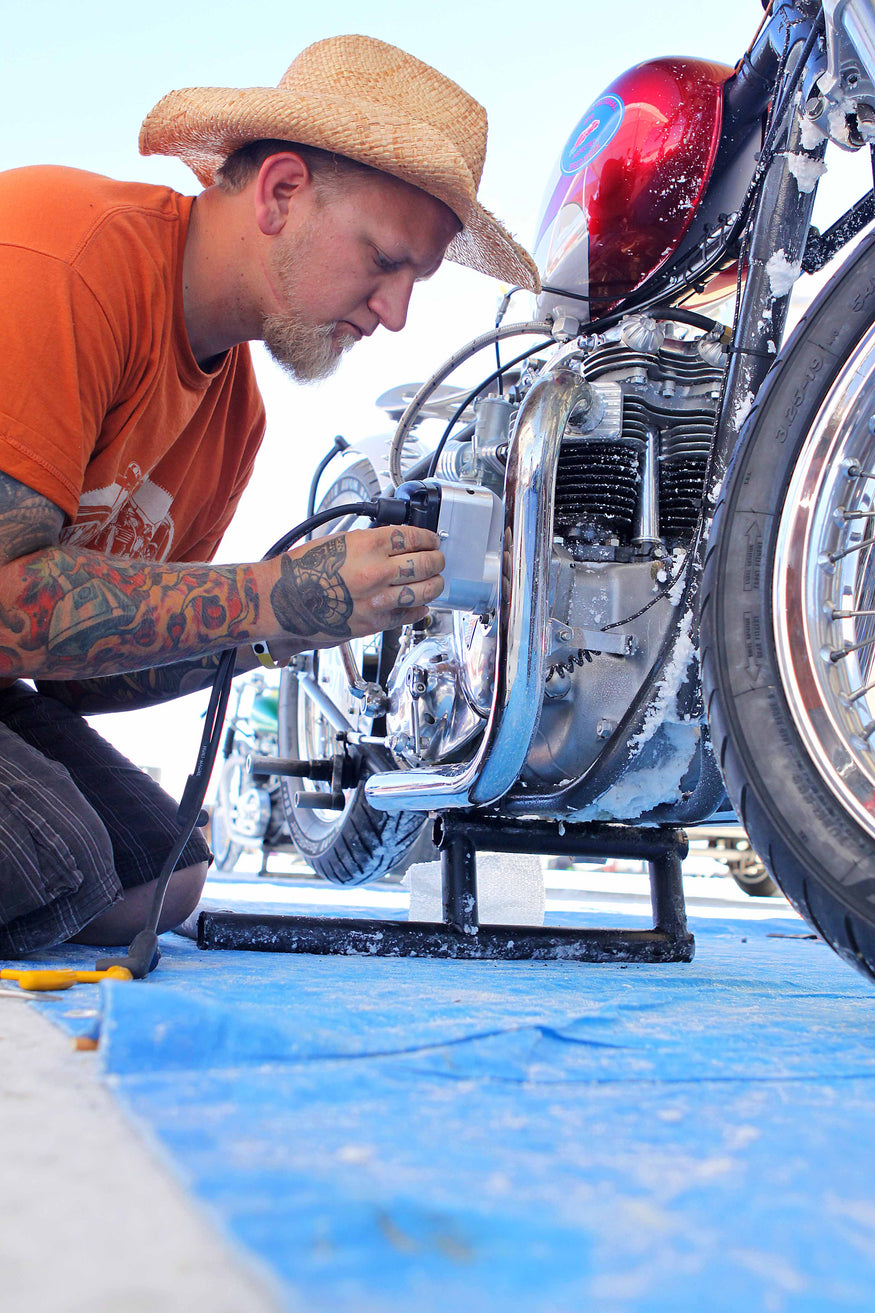
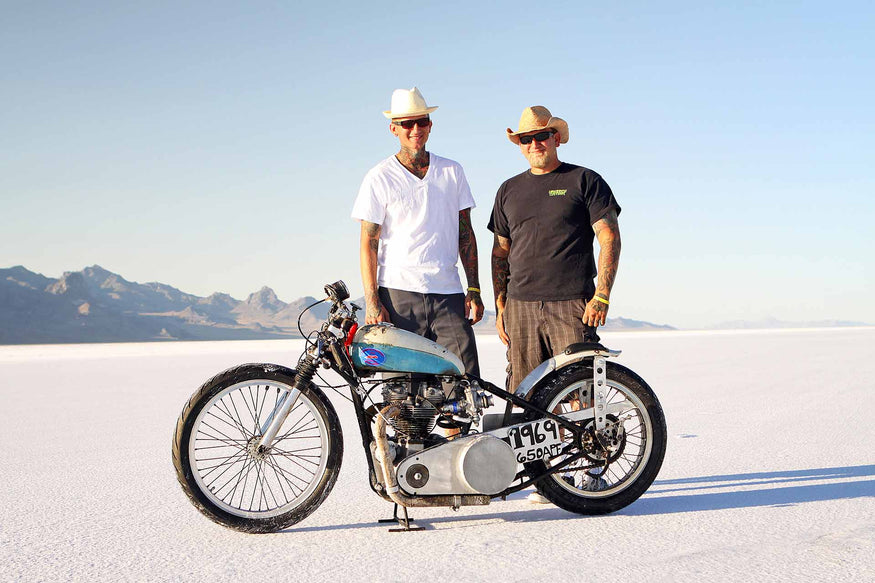
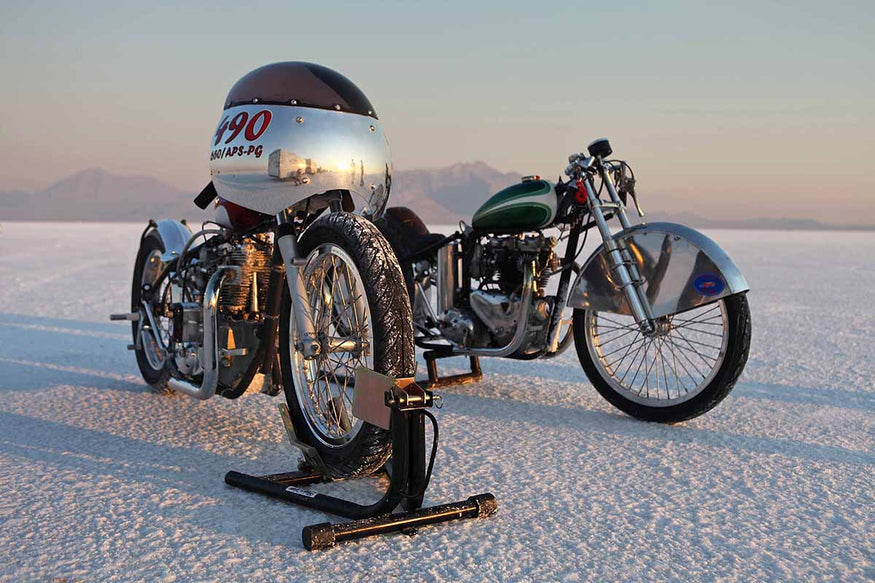
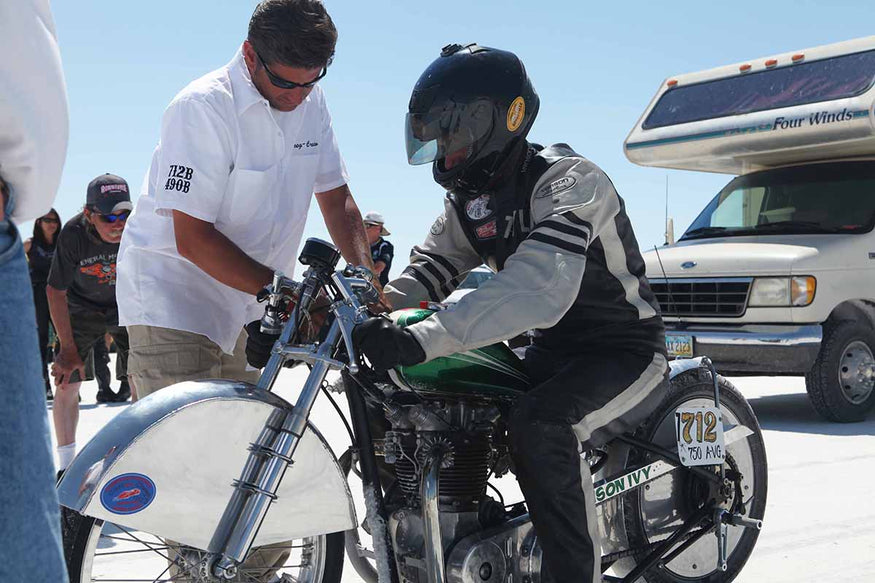
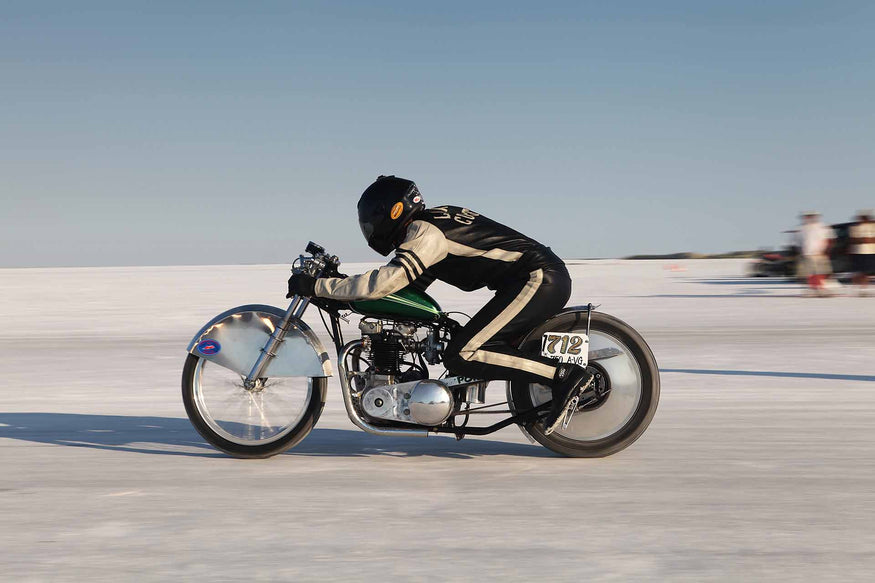

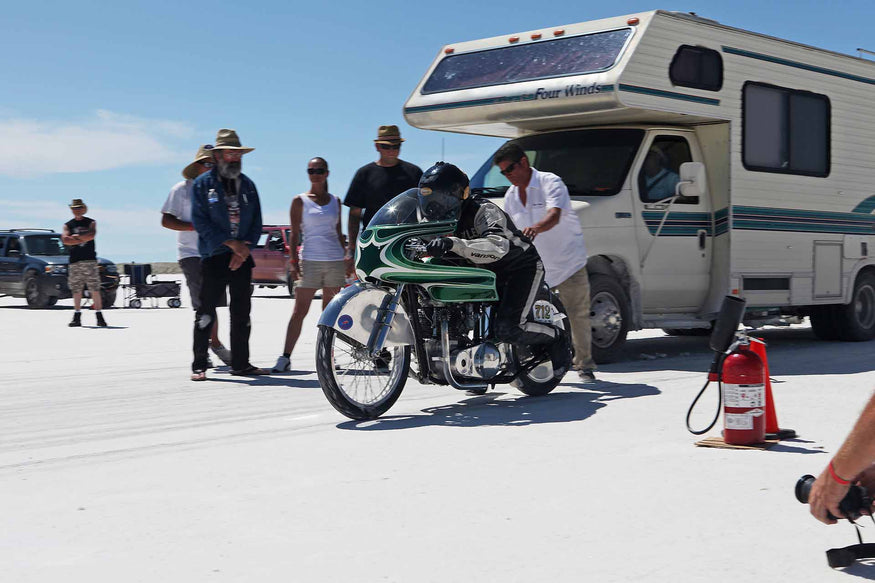

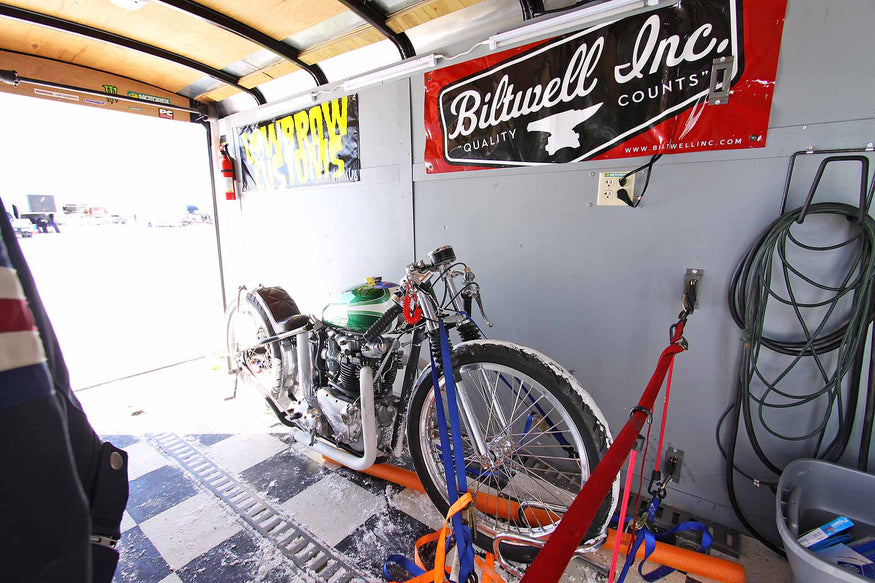

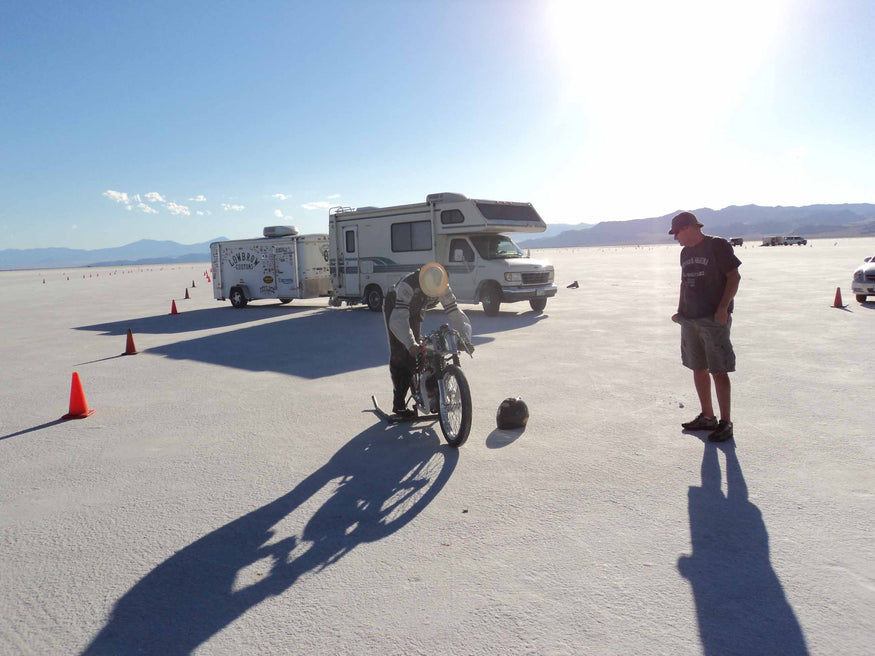

Related Posts
Related Products














